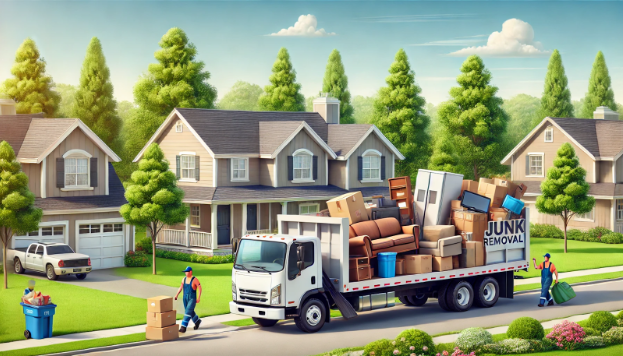
Residential Junk Removal: The Complete Guide to Decluttering Your Home
Whether you’re preparing for a big move, spring cleaning, or simply tired of clutter, residential junk removal can make the process easier and more effective. From old furniture to broken electronics, clutter builds up quickly and can make spaces feel cramped and chaotic. This guide covers the essentials of residential junk removal, from affordable options to eco-friendly practices, helping you clear out unwanted items without the stress.
Why Residential Junk Removal is Important
Getting rid of household junk doesn’t just free up physical space—it also improves your mental space. Here are some benefits of residential junk removal:
- Creates a Clean Environment: Removing clutter promotes cleanliness and can reduce allergens and dust.
- Improves Home Safety: Removing large, bulky items and old appliances prevents tripping hazards and makes spaces safer.
- Boosts Productivity: An organized home improves focus, making daily tasks easier.
- Eco-Friendly Disposal: Responsible junk removal often involves recycling and donating, reducing landfill waste and environmental impact.
Types of Residential Junk and How to Dispose of Them
Residential junk varies widely, and each type requires a different disposal approach. Here’s a breakdown of common household items and the best disposal methods.
| Type of Junk | Examples | Recommended Disposal Methods |
|---|---|---|
| Furniture | Sofas, tables, chairs, mattresses | Donation, recycling centers |
| Electronics (E-Waste) | TVs, computers, phones | E-waste recycling programs |
| Appliances | Refrigerators, washers, microwaves | Recycling or donation if functional |
| Clothing and Textiles | Clothes, linens, towels | Textile recycling, donation centers |
| Yard Waste | Branches, leaves, grass clippings | Composting, local yard waste collection |
| Construction Debris | Wood, drywall, tiles | Construction waste recycling, dumpster rental |
Popular Residential Junk Removal Services
Residential junk removal services vary in scope and cost, allowing homeowners to select options that fit their needs. Here are some of the most common service types:
1. Full-Service Junk Removal
Full-service junk removal is ideal if you want a hands-off experience. Professionals handle everything, from lifting and loading to sorting and disposal, making it a convenient choice for large or complex cleanouts.
- Best For: Large items, heavy furniture, or whole-home cleanouts.
- Pros: No heavy lifting, quick and efficient.
- Cons: Often more expensive than other methods.
2. Dumpster Rental for DIY Cleanouts
If you prefer a DIY approach, renting a dumpster gives you the flexibility to remove junk at your own pace. You can fill the dumpster as you go, and the company will pick it up when you’re ready.
- Best For: Home renovations, yard cleanups, and projects generating ongoing waste.
- Cost Range: Typically $300-$600 per week, depending on dumpster size.
- Tip: Choose the right size for your project to avoid overage fees.
3. Curbside Junk Pickup
Curbside junk pickup is a budget-friendly option where you place items at the curb, and the removal service picks them up. This works well for smaller loads or single items like an old mattress or a broken appliance.
- Best For: Small cleanouts, bulky item disposal.
- Pros: Cost-effective and convenient.
- Cons: Limited to curb-accessible items.
4. Donation Pickup for Usable Items
Many local charities offer donation pickup services, allowing you to donate usable items like furniture, electronics, and appliances. This is not only budget-friendly but also helps people in need.
- Best For: Furniture, appliances, gently used household items.
- Common Charities: Goodwill, Salvation Army, Habitat for Humanity.
- Cost: Free for most items, but check with each organization.
Affordable Tips for Residential Junk Removal
You don’t have to spend a fortune to clear out clutter. Here are some tips to make residential junk removal more affordable:
- Sort and Organize in Advance: Separate items by type—recyclable, donatable, disposable. Sorting ahead can reduce disposal costs and help identify items for donation.
- Bundle Services: Some companies offer discounted rates for bundled services, so consider consolidating multiple cleanout projects.
- Use Free Local Resources: Check if your city offers free bulk item pickup, curbside recycling, or seasonal yard waste disposal events.
- Choose Off-Peak Times: Junk removal services may offer discounts during slower seasons, so look for opportunities outside of peak spring and summer months.
Frequently Asked Questions (FAQs) on Residential Junk Removal
Q1: Can I recycle my old furniture?
A1: Many pieces of furniture can be recycled, especially if they contain wood or metal. Some recycling centers accept furniture, or you can check with junk removal companies about eco-friendly disposal.
Q2: How do I dispose of hazardous household items?
A2: Hazardous items, like paint, batteries, and certain cleaning chemicals, should never go in the trash. Look for local hazardous waste disposal events or facilities that specialize in these materials.
Q3: Are there any restrictions on what can be thrown in a dumpster rental?
A3: Yes, most dumpster rentals do not allow hazardous materials, tires, or e-waste. Be sure to review the list of restricted items with the rental provider.
Q4: Can I donate items that are gently used but not brand new?
A4: Absolutely. Most donation centers accept gently used items, including furniture, clothing, and household goods, as long as they are in good condition.
Q5: Is it cheaper to handle junk removal myself?
A5: For small loads, DIY junk removal may be cheaper. However, for larger projects, professional services often offer better value by saving you time, labor, and disposal costs.
